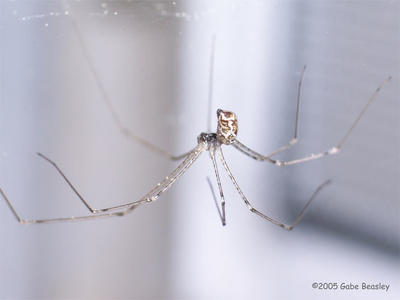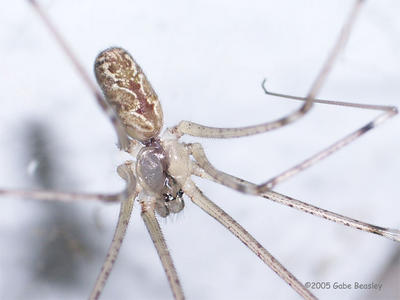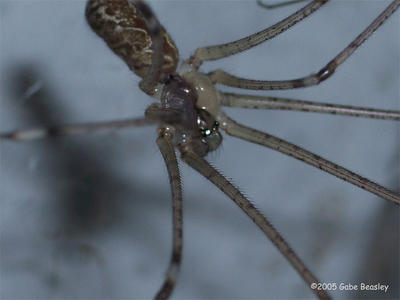 When I got to San Jose California I had no idea I’d find this! I have found a lot
When I got to San Jose California I had no idea I’d find this! I have found a lotof fascinating spiders you might call “Daddy long legs”, from the huge cave
spiders in Hawaii (probably Hypochilidae) to the huge harvestmen we have
on the Oregon Coast here. But this one is truly bizare. And it's not very big.
It’s regular sized. If it were not for my knowledge of spiders I would have
quickly wrote it off as your common Daddy Long legs spider.
(Pholcus phalangioides).
 (CLICK ON PICTURE FOR LARGER VIEW!)
(CLICK ON PICTURE FOR LARGER VIEW!)Even with what I know that is what I first thought, their body size is exactly
the same, leg length–everything. Except when you realize most of them live
in bright sunlight making more sheet like webs on shrubs! Very odd
behavior for the Pholcidae–who prefer dark places and would not build
there webs in brightly lit shrubs. The next clue what the silk and web.
The web is built much like the Money spider, an upside down sheet sort of
shape but not very organized. These are daylight loving spiders–not often
concealed in dark places. Almost all of them I found blend in well enough to shrubs
to be confident but they must not have very many predators as they are easy
to see. They seemed to love sunlight–and that is where they are found–lots
of them. The most common obvious spider in that area. There must have been
5 to 15 adults per small pine shrub. Densely packed with webs nearly
connected like the Pholcidae living in packed basements.

In every distant appearance this spider looks exactly like it’s cellar, basement
and bathroom loving counterparts. But a close look revealed these are
no regular Pholcidae. In fact, I can’t really figure out what they are. Such a common
spider just outside of San Francisco is not going to go un-noticed. So
I’m sure an experienced entomologist (unlike my armature self) could identify this
quickly. I have yet to try looking on line to find it. It’s really amazing, I like
these kind of surprises.
The similarities to your typical cellar spider ends at a closer look. They
live very much like Money spiders (Linyphiidae). They have colors,
complex colors, and then a close micro-shot of it’s abdomen and
cephalothorax shows just how bizarre and different these spiders are.
These got to be related to Pholcidae. But I can’t get over how much they
look like them at a distance. Body sizes and proportions are perfect,
leg sizes–everything. This however, in the scientific world of spiders
can mean little or nothing but a coincidence in many cases. Some
species are so similar the only difference that can truly tell are the
eye positions and very small attributes-serious detail.
 (CLICK ON THIS PICTURE FOR LARGE VIEW!)
(CLICK ON THIS PICTURE FOR LARGE VIEW!)As you can see the cephalothorax is very bizarre, and mouthparts of this
male show huge palps swelled up–but not “jacked up” the way Hypochilidae
males. It’s also a bit small for Hypochilidae but I can’t be sure until I
get a closer look on my next trip.
I do not harm spiders to photograph them and did not have enough
time on this very short trip to do more then setup these shots carefully with
my specialized lenses. These closeups were actually taken of spiders in
there webs un-disturbed! I take a lot of pride in the lenses I built that make
these kinds of shots possible. They did not display the typical shaking
associated with the daddy long legs you might find in your bathroom.
And clearly these spiders liked the sun–many of them in the full
blast of the sun and being very daytime active even on hot days.
I have no idea what this spider is. Despite the serious differences
my best guess it that it is a species of Pholcidae that is just not
in the field guides for whatever reason. Remember, to make a
field guide takes A LOT of work, most of them in print are over
25 years old and still in print. Species can often move to new
areas or even become introduced by accident in new areas in that
amount of time. An important thing unfortunately I did not take
the time to capture one and look very close to find a cribellum–I
got too caught up in the photography and stuff to think of that.
This could prove key in identifying it. The silk and web would
have shown more–but once again I was really busy on this trip
and I did not take my typical silk, spent skin shedding or eggsack
remains or samples-I did not even go find a female. This was a very quick
trip and I had very little time to do in-depth stuff. I’m headed back
however–next month. I often do that to help identify the spider later. I am
perplexed. If you think you can tell me what this San Jose spider
species is–E-MAIL ME! Or just leave a comment here.
You might ask- why did I not take a specimen?
In this day and age with digital technology being as powerful as it
is, I do not find it necessary to kill spiders or often even so much as
take them out of their web to find the distinctive features that
can identify them. I recently found a digital video camera with
4mega pixels which can take both stills and non-choppy clear video
which is only the size of a pack of cigarettes. A couple of problems
solved and you quickly have a nice macro lens on it. For $150 bucks.
The unit has about 80min high quality recording time with a
1GB internal card. Using digital video and the macro lens
comprehensives descriptions and views are very possible. A
Few stills with a trained eye and you have it–the spiders most
vital areas of identification photographed. Granted I had to
invent my own lenses for many of my cameras to become practical for
this purpose–but most higher end small digital cameras over
$300 have macro-lens kits you can buy. And of corse a digital SLR
can be outfited with anything.
A good digital camera with manual controls and at least 3.2MP
and a simple macro lens can provide a very comprehensive
description that misses almost nothing if done right. With the
right lenses and a little time a spider can be totally described
at least outwardly–without a gruesome faded specimen or a single
spider being killed. Each spider only has a lifespan in most cases
of about a year. That’s a short life. I believe that all living beings are
sentient and still battle my very scientific mind about this issue
even today. Now I disagree with taking specimens especially
for surveys and other work that could be done with cameras.
IT is more expensive and complex–but what price can you put
on life in the name of science? Why kill what you study just
to learn of it if there are alternatives. I’m sure I’d get a lot of
arguments, but someday we will have to lose the idea that
human beings are the only animals that feel pain, fear and all
those other emotions as well as self-awareness of them. Even
insects and spiders, are not mindless robots.
In the un-likely event that I’m in a situation where I really think
I’ve found a spider not known to science, I would take a specimen
as that is important complete proof. I don’t believe every
spider-enthusiast has to have a creepy collection of dead faded
spiders in order to study them.
I like spiders–I do want to kill them. As I said–the days of needing
to kill masses of spiders for surveys and or personal collections are
in my opinion over. It is a little known fact that many spider species
have become extinct at least locally or gotten very rare are close too
it areas all over the USA alone due to development and whatever
people do–such as bug spray. Some species are even protected by law,
especially in Europe. I just don’t think it is necessary anymore and
I’d prefer not to kill them. It’s also an expensive and somewhat
difficult way of doing things. Any student of entomology probably
has a story of broken or opened gruesome specimen bottles full of
faded yellow chemicals and dead spiders ruining note books and
field guides at the bottom of there favorite bag! (At least I have a few)
Digital photography is so advanced an certain–usually taking
away the short life these creatures have just is not fair or
needed anymore- usually. A final note: I realize I am an armature
here, and this is purely my opinion based upon what I know.
I do not want to seem like an activist who is not willing to listen
to other views.
Well, ##NAME##, whaddya know? You've got quite a blog there. Not exactly what I was expecting, but good. I'll make a note to look in again. Rex ##LINK##
ReplyDeleteI have been looking for sites like this for a long time. Thank you!
ReplyDelete» » »